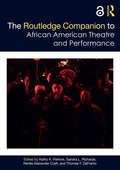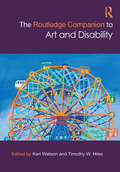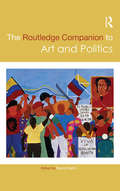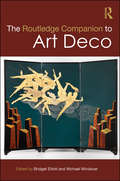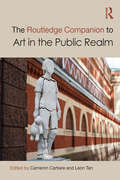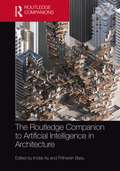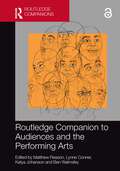- Table View
- List View
The Routledge Companion to African American Theatre and Performance (Routledge Companions)
by Kathy A. Perkins Sandra L. Richards Renée Alexander Craft Thomas F. DeFrantzThe Routledge Companion to African American Theatre and Performance is an outstanding collection of specially written essays that charts the emergence, development, and diversity of African American Theatre and Performance—from the nineteenth-century African Grove Theatre to Afrofuturism. Alongside chapters from scholars are contributions from theatre makers, including producers, theatre managers, choreographers, directors, designers, and critics. This ambitious Companion includes: A "Timeline of African American theatre and performance." Part I "Seeing ourselves onstage" explores the important experience of Black theatrical self-representation. Analyses of diverse topics including historical dramas, Broadway musicals, and experimental theatre allow readers to discover expansive articulations of Blackness. Part II "Institution building" highlights institutions that have nurtured Black people both on stage and behind the scenes. Topics include Historically Black Colleges and Universities (HBCUs), festivals, and black actor training. Part III "Theatre and social change" surveys key moments when Black people harnessed the power of theatre to affirm community realities and posit new representations for themselves and the nation as a whole. Topics include Du Bois and African Muslims, women of the Black Arts Movement, Afro-Latinx theatre, youth theatre, and operatic sustenance for an Afro future. Part IV "Expanding the traditional stage" examines Black performance traditions that privilege Black worldviews, sense-making, rituals, and innovation in everyday life. This section explores performances that prefer the space of the kitchen, classroom, club, or field. This book engages a wide audience of scholars, students, and theatre practitioners with its unprecedented breadth. More than anything, these invaluable insights not only offer a window onto the processes of producing work, but also the labour and economic issues that have shaped and enabled African American theatre.
The Routledge Companion to Architectural Drawings and Models: From Translating to Archiving, Collecting and Displaying (Routledge International Handbooks)
by Federica GoffiArchitectural drawings and models are instruments of imagination, communication, and historical continuity. The role of drawings and models, and their ownership, placement, and authorship in a ubiquitous digital age deserve careful consideration. Expanding on the well-established discussion of the translation from drawings to buildings, this book fills a lacuna in current scholarship, questioning the significance of the lives of drawings and models after construction. Including emerging, well-known, and world-renowned scholars in the fields of architectural history and theory and curatorial practices, the thirty-five contributions define recent research in four key areas: drawing sites/sites of knowledge construction: drawing, office, construction site; the afterlife of drawings and models: archiving, collecting, displaying, and exhibiting; tools of making: architectural representations and their apparatus over time; and the ethical responsibilities of collecting and archiving: authorship, ownership, copyrights, and rights to copy. The research covers a wide range of geographies and delves into the practices of such architects as Sir John Soane, Superstudio, Eugène-Emmanuel Viollet-le-Duc, Frank Lloyd Wright, Wajiro Kon, Germán Samper Gnecco, A+PS, Mies van der Rohe, and Renzo Piano.
The Routledge Companion to Architectural Drawings and Models: From Translating to Archiving, Collecting and Displaying (Routledge International Handbooks)
by Federica GoffiArchitectural drawings and models are instruments of imagination, communication, and historical continuity. The role of drawings and models, and their ownership, placement, and authorship in a ubiquitous digital age deserve careful consideration. Expanding on the well-established discussion of the translation from drawings to buildings, this book fills a lacuna in current scholarship, questioning the significance of the lives of drawings and models after construction. Including emerging, well-known, and world-renowned scholars in the fields of architectural history and theory and curatorial practices, the thirty-five contributions define recent research in four key areas: drawing sites/sites of knowledge construction: drawing, office, construction site; the afterlife of drawings and models: archiving, collecting, displaying, and exhibiting; tools of making: architectural representations and their apparatus over time; and the ethical responsibilities of collecting and archiving: authorship, ownership, copyrights, and rights to copy. The research covers a wide range of geographies and delves into the practices of such architects as Sir John Soane, Superstudio, Eugène-Emmanuel Viollet-le-Duc, Frank Lloyd Wright, Wajiro Kon, Germán Samper Gnecco, A+PS, Mies van der Rohe, and Renzo Piano.
The Routledge Companion to Architectural Pedagogies of the Global South (Routledge International Handbooks)
by Harriet HarrissThe established canon of architectural pedagogy has been predominantly produced within the Northern hemisphere and transposed – or imposed – across schools within the Global South, more often, with scant regard for social, economic, political or ecological culture and context, nor regional or indigenous pedagogic principles and practices. Throughout the Global South, architecture’s academic community has been deeply affected by this regime, how it shapes and influences proto-professionals and by implication architectural processes and outcomes, too. The Routledge Companion to Architectural Pedagogies of the Global South resituates and recenters an array of pedagogic approaches that are either produced or proliferate from the ‘Global South’ while antagonizing the linguistic, epistemological and disciplinary conceits that, under imperialist imperatives, ensured that these pedagogies remained maligned or marginalized. The book maintains that the exclusionary implications of architectural notions of the ‘orders’, the ‘canon’ and the ‘core’ have served to constrain and to calcify its contents and in doing so, imperiled its relevance and impact. In contrast, this companion of pedagogic approaches serves to evidence that architecture’s academic and professional advancement is wholly contingent on its ability to fully engage in an additive and inclusive process whereby the necessary disruptions that occur when marginalized knowledge confronts established knowledge result in a catalytical transformation through which new, co-created knowledge can emerge. Notions of tradition, identity, modernity, vernacularism, post-colonialism, poverty, migration, social and spatial justice, climate apartheid, globalization, ethical standards and international partnerships are key considerations in the context of the Global South. How these issues originate and evolve within architectural schools and curricula and how they act as drivers across all curricula activities are some of the important themes that the contributors interrogate and debate. With more than 30 contributions from 55 authors from diverse regional, racial, ethnic, gender and cultural backgrounds, this companion is structured in four sections that capture, critique and catalog multifarious marginalized pedagogical approaches to provide educators and students with an essential source book of navigational steers, core contestations, propositional tactics and reimagined rubrics. The Routledge Companion to Architectural Pedagogies of the Global South pioneers a transposable strategy for academics from all disciplines looking to adopt a tested approach to decolonizing the curriculum. It is only through a process of destabilizing the hegemonic, epistemological and disciplinary frameworks that have long-prescribed architecture’s pedagogies that the possibility of more inclusive, representative and relevant pedagogical practices can emerge.
The Routledge Companion to Architectural Pedagogies of the Global South (Routledge International Handbooks)
by Harriet Harriss Ashraf M. Salama Ane Gonzalez LaraThe established canon of architectural pedagogy has been predominantly produced within the Northern hemisphere and transposed – or imposed – across schools within the Global South, more often, with scant regard for social, economic, political or ecological culture and context, nor regional or indigenous pedagogic principles and practices. Throughout the Global South, architecture’s academic community has been deeply affected by this regime, how it shapes and influences proto-professionals and by implication architectural processes and outcomes, too. The Routledge Companion to Architectural Pedagogies of the Global South resituates and recenters an array of pedagogic approaches that are either produced or proliferate from the ‘Global South’ while antagonizing the linguistic, epistemological and disciplinary conceits that, under imperialist imperatives, ensured that these pedagogies remained maligned or marginalized. The book maintains that the exclusionary implications of architectural notions of the ‘orders’, the ‘canon’ and the ‘core’ have served to constrain and to calcify its contents and in doing so, imperiled its relevance and impact. In contrast, this companion of pedagogic approaches serves to evidence that architecture’s academic and professional advancement is wholly contingent on its ability to fully engage in an additive and inclusive process whereby the necessary disruptions that occur when marginalized knowledge confronts established knowledge result in a catalytical transformation through which new, co-created knowledge can emerge. Notions of tradition, identity, modernity, vernacularism, post-colonialism, poverty, migration, social and spatial justice, climate apartheid, globalization, ethical standards and international partnerships are key considerations in the context of the Global South. How these issues originate and evolve within architectural schools and curricula and how they act as drivers across all curricula activities are some of the important themes that the contributors interrogate and debate. With more than 30 contributions from 55 authors from diverse regional, racial, ethnic, gender and cultural backgrounds, this companion is structured in four sections that capture, critique and catalog multifarious marginalized pedagogical approaches to provide educators and students with an essential source book of navigational steers, core contestations, propositional tactics and reimagined rubrics. The Routledge Companion to Architectural Pedagogies of the Global South pioneers a transposable strategy for academics from all disciplines looking to adopt a tested approach to decolonizing the curriculum. It is only through a process of destabilizing the hegemonic, epistemological and disciplinary frameworks that have long-prescribed architecture’s pedagogies that the possibility of more inclusive, representative and relevant pedagogical practices can emerge.
The Routledge Companion to Architecture and Social Engagement
by Farhan KarimSocially engaged architecture is a broad and emerging architectural genre that promises to redefine architecture from a market-driven profession to a mix of social business, altruism, and activism that intends to eradicate poverty, resolve social exclusion, and construct an egalitarian global society. The Routledge Companion to Architecture and Social Engagement offers a critical enquiry of socially engaged architecture’s current context characterized by socio-economic inequity, climate change, war, increasing global poverty, microfinance, the evolving notion of professionalism, the changing conception of public, and finally the growing academic interest in re-visioning the social role of architecture. Organized around case studies from the United States, Brazil, Venezuela, the United Kingdom, South Africa, Rwanda, Burkina Faso, Nigeria, Nepal, Pakistan, Iran, Thailand, Germany, Australia, Taiwan, and Japan the book documents the most important recent developments in the field. By examining diverse working methods and philosophies of socially engaged architecture, the handbook shows how socially engaged architecture is entangled in the global politics of poverty, reconstruction of the public sphere, changing role of the state, charity, and neoliberal urbanism. The book presents debates around the issue of whether architecture actually empowers the participators and alleviates socio-economic exclusion or if it instead indirectly sustains an exploitive capitalism. Bringing together a range of theories and case studies, this companion offers a platform to facilitate future lines of inquiry in education, research, and practice.
The Routledge Companion to Architecture and Social Engagement
by Farhan KarimSocially engaged architecture is a broad and emerging architectural genre that promises to redefine architecture from a market-driven profession to a mix of social business, altruism, and activism that intends to eradicate poverty, resolve social exclusion, and construct an egalitarian global society. The Routledge Companion to Architecture and Social Engagement offers a critical enquiry of socially engaged architecture’s current context characterized by socio-economic inequity, climate change, war, increasing global poverty, microfinance, the evolving notion of professionalism, the changing conception of public, and finally the growing academic interest in re-visioning the social role of architecture. Organized around case studies from the United States, Brazil, Venezuela, the United Kingdom, South Africa, Rwanda, Burkina Faso, Nigeria, Nepal, Pakistan, Iran, Thailand, Germany, Australia, Taiwan, and Japan the book documents the most important recent developments in the field. By examining diverse working methods and philosophies of socially engaged architecture, the handbook shows how socially engaged architecture is entangled in the global politics of poverty, reconstruction of the public sphere, changing role of the state, charity, and neoliberal urbanism. The book presents debates around the issue of whether architecture actually empowers the participators and alleviates socio-economic exclusion or if it instead indirectly sustains an exploitive capitalism. Bringing together a range of theories and case studies, this companion offers a platform to facilitate future lines of inquiry in education, research, and practice.
The Routledge Companion to Art and Activism in the Twenty-First Century (Routledge Art History and Visual Studies Companions)
by Lesley Shipley Mey-Yen MoriuchiThe Routledge Companion to Art and Activism in the Twenty-First Century brings together a wide range of geographical, cultural, historical, and conceptual perspectives in a single volume of new essays that facilitate a deeper understanding of the field of art activism as it stands today and as it looks towards the future. The book is a resource for multiple fields, including art activism, socially engaged art, and contemporary art, that represent the depth and breadth of contemporary activist art worldwide. Contributors highlight predominant lines of inquiry, uncover challenges faced by scholars and practitioners of activist art, and facilitate dialogue that might lead to new directions for research and practice. The editors hope that the volume will incite further conversation and collaboration among the various participants, practitioners, and researchers concerned with the relationship between art and activism. The audience includes scholars and professors of modern and contemporary art, students in both graduate and upper-level undergraduate programs, as well as artists, curators, and museum professionals. Each chapter can stand on its own, making the companion a flexible resource for students and educators working in art history, museum studies, community practice/socially engaged art, political science, sociology, and ethnic and cultural studies.
The Routledge Companion to Art and Activism in the Twenty-First Century (Routledge Art History and Visual Studies Companions)
by Lesley Shipley Mey-Yen MoriuchiThe Routledge Companion to Art and Activism in the Twenty-First Century brings together a wide range of geographical, cultural, historical, and conceptual perspectives in a single volume of new essays that facilitate a deeper understanding of the field of art activism as it stands today and as it looks towards the future. The book is a resource for multiple fields, including art activism, socially engaged art, and contemporary art, that represent the depth and breadth of contemporary activist art worldwide. Contributors highlight predominant lines of inquiry, uncover challenges faced by scholars and practitioners of activist art, and facilitate dialogue that might lead to new directions for research and practice. The editors hope that the volume will incite further conversation and collaboration among the various participants, practitioners, and researchers concerned with the relationship between art and activism. The audience includes scholars and professors of modern and contemporary art, students in both graduate and upper-level undergraduate programs, as well as artists, curators, and museum professionals. Each chapter can stand on its own, making the companion a flexible resource for students and educators working in art history, museum studies, community practice/socially engaged art, political science, sociology, and ethnic and cultural studies.
The Routledge Companion to Art and Disability (Routledge Art History and Visual Studies Companions)
by Keri Watson Timothy W. HilesThe Routledge Companion to Art and Disability explores disability in visual culture to uncover the ways in which bodily and cognitive differences are articulated physically and theoretically, and to demonstrate the ways in which disability is culturally constructed. This companion is organized thematically and includes artists from across historical periods and cultures in order to demonstrate the ways in which disability is historically and culturally contingent. The book engages with questions such as: How are people with disabilities represented in art? How are notions of disability articulated in relation to ideas of normality, hybridity, and anomaly? How do artists use visual culture to affirm or subvert notions of the normative body? Contributors consider the changing role of disability in visual culture, the place of representations in society, and the ways in which disability studies engages with and critiques intersectional notions of gender, race, ethnicity, class, and sexuality.This book will be particularly useful for scholars in art history, disability studies, visual culture, and museum studies.
The Routledge Companion to Art and Disability (Routledge Art History and Visual Studies Companions)
by Keri Watson Timothy W. HilesThe Routledge Companion to Art and Disability explores disability in visual culture to uncover the ways in which bodily and cognitive differences are articulated physically and theoretically, and to demonstrate the ways in which disability is culturally constructed. This companion is organized thematically and includes artists from across historical periods and cultures in order to demonstrate the ways in which disability is historically and culturally contingent. The book engages with questions such as: How are people with disabilities represented in art? How are notions of disability articulated in relation to ideas of normality, hybridity, and anomaly? How do artists use visual culture to affirm or subvert notions of the normative body? Contributors consider the changing role of disability in visual culture, the place of representations in society, and the ways in which disability studies engages with and critiques intersectional notions of gender, race, ethnicity, class, and sexuality.This book will be particularly useful for scholars in art history, disability studies, visual culture, and museum studies.
The Routledge Companion to Art and Politics (Routledge Art History and Visual Studies Companions)
by Randy MartinThe Routledge Companion to Art and Politics offers a thorough examination of the complex relationship between art and politics, and the many forms and approaches the engagement between them can take. The contributors - a diverse assembly of artists, activists, scholars from around the world – discuss and demonstrate ways of making art and politics legible and salient in the world. As such the 32 chapters in this volume reflect on performing and visual arts; music, film and new media; as well as covering social practice, community-based work, conceptual, interventionist and movement affiliated forms. The Companion is divided into four distinct parts: Conceptual Cartographies Institutional Materialities Modalities of Practice Making Publics Randy Martin has assembled a collection that ensures that readers will come away with a wider view of what can count as art and politics; where they might find it; and how it moves in the world. The diversity of perspectives is at once challenging and fortifying to those who might dismiss political art on the one hand as not making sufficient difference and on the other to those embracing it but seeking a means to elaborate the significance that it can make in the world. The Routledge Companion to Art and Politics brings together a range of issues and approaches and encourages critical and creative thinking about how art is produced, perceived, and received.
The Routledge Companion to Art and Politics (Routledge Art History and Visual Studies Companions)
by Randy Martin Victor J. PetersonThe Routledge Companion to Art and Politics offers a thorough examination of the complex relationship between art and politics, and the many forms and approaches the engagement between them can take. The contributors - a diverse assembly of artists, activists, scholars from around the world – discuss and demonstrate ways of making art and politics legible and salient in the world. As such the 32 chapters in this volume reflect on performing and visual arts; music, film and new media; as well as covering social practice, community-based work, conceptual, interventionist and movement affiliated forms. The Companion is divided into four distinct parts: Conceptual Cartographies Institutional Materialities Modalities of Practice Making Publics Randy Martin has assembled a collection that ensures that readers will come away with a wider view of what can count as art and politics; where they might find it; and how it moves in the world. The diversity of perspectives is at once challenging and fortifying to those who might dismiss political art on the one hand as not making sufficient difference and on the other to those embracing it but seeking a means to elaborate the significance that it can make in the world. The Routledge Companion to Art and Politics brings together a range of issues and approaches and encourages critical and creative thinking about how art is produced, perceived, and received.
The Routledge Companion to Art Deco (Routledge Art History and Visual Studies Companions)
by Bridget Elliott Michael WindoverScholarly interest in Art Deco has grown rapidly over the past fifty years, spanning different academic disciplines. This volume provides a guide to the current state of the field of Art Deco research by highlighting past accomplishments and promising new directions. Chapters are presented in five sections based on key concepts: migration, public culture, fashion, politics, and Art Deco’s afterlife in heritage restoration and new media. The book provides a range of perspectives on and approaches to these issues, as well as to the concept of Art Deco itself. It highlights the slipperiness of Art Deco yet points to its potential to shed new light on the complexities of modernity.
The Routledge Companion to Art Deco (Routledge Art History and Visual Studies Companions)
by Bridget Elliott Michael WindoverScholarly interest in Art Deco has grown rapidly over the past fifty years, spanning different academic disciplines. This volume provides a guide to the current state of the field of Art Deco research by highlighting past accomplishments and promising new directions. Chapters are presented in five sections based on key concepts: migration, public culture, fashion, politics, and Art Deco’s afterlife in heritage restoration and new media. The book provides a range of perspectives on and approaches to these issues, as well as to the concept of Art Deco itself. It highlights the slipperiness of Art Deco yet points to its potential to shed new light on the complexities of modernity.
The Routledge Companion to Art in the Public Realm (Routledge Art History and Visual Studies Companions)
by Cameron CartiereThis multidisciplinary companion offers a comprehensive overview of the global arena of public art.It is organised around four distinct topics: activation, social justice, memory and identity, and ecology, with a final chapter mapping significant works of public and social practice art around the world between 2008 and 2018. The thematic approach brings into view similarities and differences in the recent globalisation of public art practices, while the multidisciplinary emphasis allows for a consideration of the complex outcomes and consequences of such practices, as they engage different disciplines and communities and affect a diversity of audiences beyond the existing 'art world'. The book will highlight an international selection of artist projects that illustrate the themes.This book will be of interest to scholars in contemporary art, art history, urban studies, and museum studies.
The Routledge Companion to Art in the Public Realm (Routledge Art History and Visual Studies Companions)
by Cameron Cartiere Leon TanThis multidisciplinary companion offers a comprehensive overview of the global arena of public art.It is organised around four distinct topics: activation, social justice, memory and identity, and ecology, with a final chapter mapping significant works of public and social practice art around the world between 2008 and 2018. The thematic approach brings into view similarities and differences in the recent globalisation of public art practices, while the multidisciplinary emphasis allows for a consideration of the complex outcomes and consequences of such practices, as they engage different disciplines and communities and affect a diversity of audiences beyond the existing 'art world'. The book will highlight an international selection of artist projects that illustrate the themes.This book will be of interest to scholars in contemporary art, art history, urban studies, and museum studies.
The Routledge Companion to Artificial Intelligence in Architecture
by Imdat As Prithwish BasuProviding the most comprehensive source available, this book surveys the state of the art in artificial intelligence (AI) as it relates to architecture. This book is organized in four parts: theoretical foundations, tools and techniques, AI in research, and AI in architectural practice. It provides a framework for the issues surrounding AI and offers a variety of perspectives. It contains 24 consistently illustrated contributions examining seminal work on AI from around the world, including the United States, Europe, and Asia. It articulates current theoretical and practical methods, offers critical views on tools and techniques, and suggests future directions for meaningful uses of AI technology. Architects and educators who are concerned with the advent of AI and its ramifications for the design industry will find this book an essential reference.
The Routledge Companion to Artificial Intelligence in Architecture
by Imdat As and Prithwish BasuProviding the most comprehensive source available, this book surveys the state of the art in artificial intelligence (AI) as it relates to architecture. This book is organized in four parts: theoretical foundations, tools and techniques, AI in research, and AI in architectural practice. It provides a framework for the issues surrounding AI and offers a variety of perspectives. It contains 24 consistently illustrated contributions examining seminal work on AI from around the world, including the United States, Europe, and Asia. It articulates current theoretical and practical methods, offers critical views on tools and techniques, and suggests future directions for meaningful uses of AI technology. Architects and educators who are concerned with the advent of AI and its ramifications for the design industry will find this book an essential reference.
The Routledge Companion to Arts Marketing (Routledge Companions in Business, Management and Marketing)
by Daragh O'Reilly, Ruth Rentschler and Theresa A. KirchnerThe relationship between the arts and marketing has been growing ever more complex, as the proliferation of new technologies and social media has opened up new forms of communication. This book covers the broad and involved relationship between the arts and marketing. It frames "arts marketing" in the context of wider, related issues, such as the creative and cultural industries, cultural policy and arts funding, developments in the different art forms and the impact of environmental forces on arts business models and markets. The Routledge Companion to Arts Marketing provides a comprehensive, up-to-date reference guide that incorporates current analyses of arts marketing topics by leaders of academic research in the field. As such, it will be a key resource for the next generation of arts marketing scholars and teachers and will constitute the single most authoritative guide on the subject internationally.
The Routledge Companion to Arts Marketing (Routledge Companions in Business, Management and Marketing)
by Ruth Rentschler Theresa A. Kirchner Daragh O'ReillyThe relationship between the arts and marketing has been growing ever more complex, as the proliferation of new technologies and social media has opened up new forms of communication. This book covers the broad and involved relationship between the arts and marketing. It frames "arts marketing" in the context of wider, related issues, such as the creative and cultural industries, cultural policy and arts funding, developments in the different art forms and the impact of environmental forces on arts business models and markets. The Routledge Companion to Arts Marketing provides a comprehensive, up-to-date reference guide that incorporates current analyses of arts marketing topics by leaders of academic research in the field. As such, it will be a key resource for the next generation of arts marketing scholars and teachers and will constitute the single most authoritative guide on the subject internationally.
Routledge Companion to Audiences and the Performing Arts (Audience Research)
by Matthew ReasonThe Routledge Companion to Audiences and the Performing Arts represents a truly multi-dimensional exploration of the inter-relationships between audiences and performance. This study considers audiences contextually and historically, through both qualitative and quantitative empirical research, and places them within appropriate philosophical and socio-cultural discourses. Ultimately, the collection marks the point where audiences have become central and essential not just to the act of performance itself but also to theatre, dance, opera, music and performance studies as academic disciplines. This Companion will be of great interest to academics, researchers and postgraduates, as well as to theatre, dance, opera and music practitioners and performing arts organisations and stakeholders involved in educational activities.
Routledge Companion to Audiences and the Performing Arts (Audience Research)
by Matthew Reason Lynne Conner Katya Johanson Ben WalmsleyThe Routledge Companion to Audiences and the Performing Arts represents a truly multi-dimensional exploration of the inter-relationships between audiences and performance. This study considers audiences contextually and historically, through both qualitative and quantitative empirical research, and places them within appropriate philosophical and socio-cultural discourses. Ultimately, the collection marks the point where audiences have become central and essential not just to the act of performance itself but also to theatre, dance, opera, music and performance studies as academic disciplines. This Companion will be of great interest to academics, researchers and postgraduates, as well as to theatre, dance, opera and music practitioners and performing arts organisations and stakeholders involved in educational activities.
The Routledge Companion to Automobile Heritage, Culture, and Preservation (Routledge Companions)
by Barry Stiefel Jennifer ClarkThe Routledge Companion to Automobile Heritage, Culture, and Preservation explores automotive heritage, its place in society, and the ways we might preserve and conserve it. Drawing on contributions from academics and practitioners around the world and comprising six sections, this volume carries the heritage discourse forward by exploring the complex and sometimes intricate place of automobiles within society. Taken as a whole, this book helps to shape how we think about automobile heritage and considers how that heritage explores a range of cultural, intellectual, emotional, and material elements well outside of the automobile body itself. Most importantly, perhaps, it questions how we might better acknowledge the importance of automotive heritage now and in the future. The Routledge Companion to Automobile Heritage, Culture, and Preservation is unique in that it juxtaposes theory with practice, academic approaches with practical experience, and recognizes that issues of preservation and conservation belong in a broad context. As such, this volume should be essential reading for both academics and practitioners with an interest in automobiles, cultural heritage, and preservation.
The Routledge Companion to Automobile Heritage, Culture, and Preservation (Routledge Companions)
by Barry Stiefel Jennifer ClarkThe Routledge Companion to Automobile Heritage, Culture, and Preservation explores automotive heritage, its place in society, and the ways we might preserve and conserve it. Drawing on contributions from academics and practitioners around the world and comprising six sections, this volume carries the heritage discourse forward by exploring the complex and sometimes intricate place of automobiles within society. Taken as a whole, this book helps to shape how we think about automobile heritage and considers how that heritage explores a range of cultural, intellectual, emotional, and material elements well outside of the automobile body itself. Most importantly, perhaps, it questions how we might better acknowledge the importance of automotive heritage now and in the future. The Routledge Companion to Automobile Heritage, Culture, and Preservation is unique in that it juxtaposes theory with practice, academic approaches with practical experience, and recognizes that issues of preservation and conservation belong in a broad context. As such, this volume should be essential reading for both academics and practitioners with an interest in automobiles, cultural heritage, and preservation.
